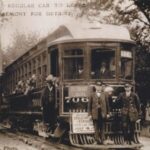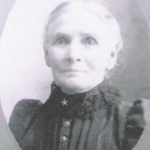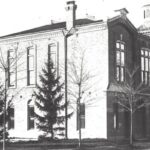Fire has altered the Almont’s downtown area and community organizations on multiple occasions.
The first known large-scale fire occurred in March of 1842 and destroyed most of the downtown. Many of these buildings were probably still log cabins. Unfortunately, also destroyed in this fire were the early Township records. What we know today of the formation of the Township is based on interviews with the participants done shortly after this fire. The downtown was reconstructed but as wood frame structures and not log cabins. In 1848, Daniel Black built the first brick structure, which was located near where his tavern and home had been on the northwest corner of downtown.
The next major fire occurred in 1859 and took down most of the buildings on the northwest section downtown. Daniel Black’s brick building was one of those that was destroyed. The museum building survived this fire. Again, Almont rebuilt.
Two years later on September 20, 1861 a fire began in the Hazen & Harris dry goods store. John Harris was careless while filling a container with kerosene and the kerosene gas fumes ignited. Mr. Harris was badly burned but survived. A number of nearby buildings along the northeast side of Main Street were also destroyed. W. P. Beach saved his building by tearing down the recently constructed but not finished building next to his store.
On November 30, 1871, the first Congregational Church burned. It was a Sunday and Thanksgiving. It was an extremely cold day and the church was full. The person in charge of tending the stove had loaded the furnace to the point that the stove was so hot that it set the church on fire. Just as the final hymn was being finished, people
realized that the church was on fired. A bucket line was unsuccessful in putting the fire out. Like with the 1861 fire, the home located between the church and the Currier Agricultural Works was torn down to prevent the spread of the fire.
About 1878, after the church fire, the Village dug a well and constructed a water tower. They also purchased a hand pump fire hose cart. By 1880 they constructed a shed to house the cart, which was located on Main Street, south of School Street.
The Union School on Church Street was constructed in 1867. In 1881, the 60,000 wood roof shingles were replaced. The shingles taken from the roof were store in the basement by the furnaces. It was the intent to burn the shingles instead of coal to heat the school and save some money. Once the fire was discovered, a bucket line from the well in front of the school was formed to try and put the fire out.
For over an hour no one went to get the cart. Finally, several teenagers brought the cart to the fire. The adults had no confidence in the cart and suggested pushing it into the fire so the village could get a bigger and better one. The teenagers dropped the hose into the well and began operating the pump. The cart put out enough water that it was felt that if it had been brought to the fire immediately, that the building could have been saved.
In those days, there was no organized fire department. The Village employed two fire wardens whose job it was to inspect stoves and stove pipes. They also, probably took the lead in fight any fires but that is not known with any certainty.
On October 28, 1882, the Village ordered a new hand fire engine (upgrade from the hose cart). On September 25, 1883 the fire department was organized and a barn was rented to house the fire engine. They also constructed several cisterns around town to supply water for fires. It wasn’t until April 28, 1885 that L. O. Folsom was appointed the first fire chief. The Village Council had control over the fire department before that date.
The last two major fires to occur in the 1800s both happened in 1894. One destroyed all of the building south of the Masonic Hall (Randazoo’s) on the southwest side of Main Street. The other fire took down all of the buildings north of the Ferguson Bank building (Almont Donut Shop) on the northeast side of Main Street.




